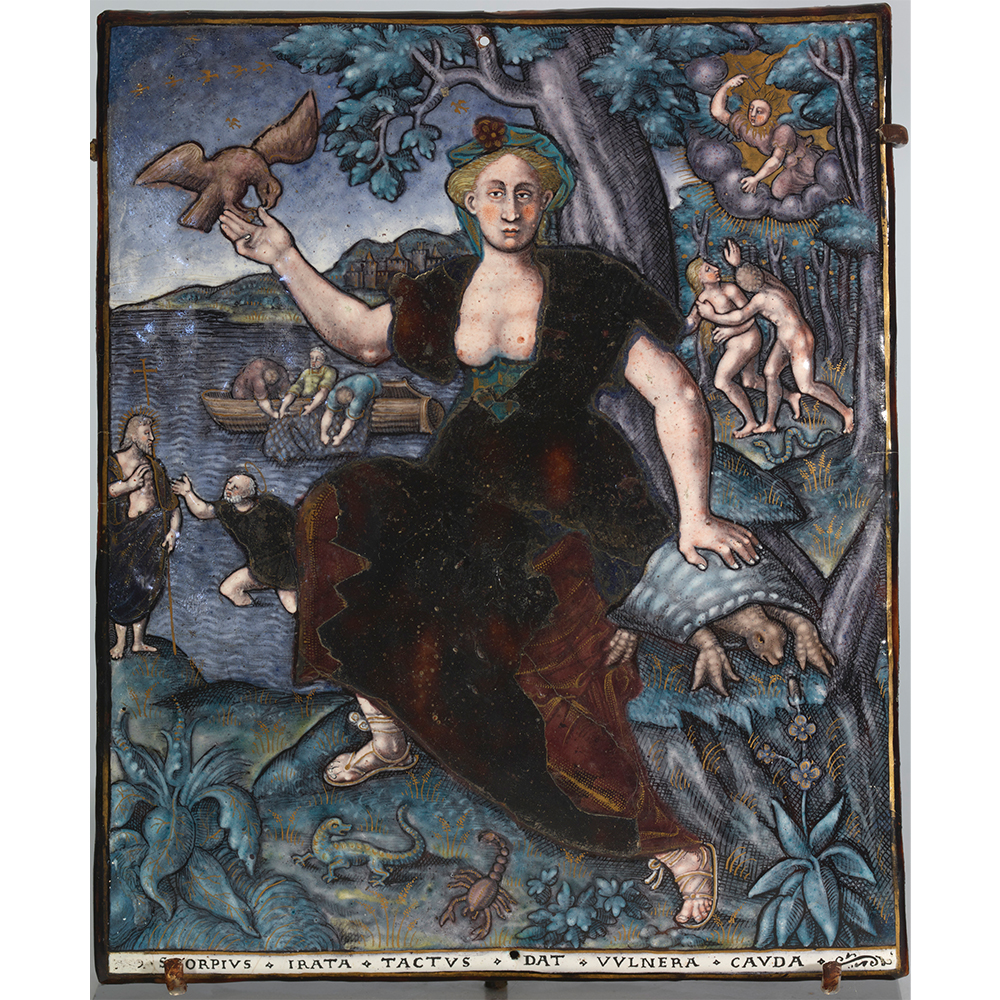Plaque with the Personification of Touch

c.1600
Attributed to Master IDC
Present-day France (Limoges)
Painted enamel on copper, gold
Height: 8 in (20.2 cm); width: 6.6 in (16.7 cm)
Wyvern Collection, 0775
Based on a print originally produced by Marten de Vos, The Personification of Touch comes from one of the famed enamel workshops of Limoges, France. The plaque demonstrates the emergent interest in secular works during the transition between the medieval period and the Northern Renaissance around the fifteenth and sixteenth century. Secular works were created throughout the medieval period, but they were increasingly produced at this time to cater to Europe’s humanist upper classes, as this well-educated elite audience shifted its focus from the Church towards worldly matters. The plaque’s medium, size, and subject matter indicate that it was a private commission, meant to be contemplated closely for an extended period of time, potentially even discussed with guests and friends. The carefully crafted detail apparent in the work would certainly entertain viewers, providing them with an opportunity to consider the meaning of each small animal and plant and to show off their academic prowess through conversations about the work.
In allegorical series representing the five senses, a popular subject matter in this period, the senses were personified as women, a choice that reflected an increased interest in engaging with the classical tradition, and a medieval association of femininity with sensuality. (1) Here, the hands of the figure “Touch” come into contact with two animals—a tortoise and a bird—with very different textures. She is framed by depictions of Adam and Eve cast out of the Garden of Eden to her left (Genesis 3:23) and the miracle of Christ walking on water (Matthew 14:22–33) to her right. Due to the Christian association of “left” (sinistra in Latin) with Satan and “right” (dexterain Latin) with the righteous path, these stories’ positions emphasize a clear “bad” and “good.” In turn, the choice to seat the allegorical figure between these biblical episodes asks viewers a stark moral question: confronted by Touch, will you follow in the steps of Adam and fall into sin, or will you follow in the steps of Christ and rise above such profane pleasures?
With an abbreviated Latin inscription at the bottom of the enamel, the work reveals its intellectual associations, implying that its owner was highly educated. This is further emphasized by the allegorical figure’s outfit, which has been heavily repaired, leading to a loss of some details. She wears lace-up sandals and a dress originally covered in lines depicting drapery, which would have been interpreted as classicizing, complementing the biblical tales with humanist references. By the 1530s, artisans in Limoges had begun producing many works with classical themes, so such clothing would have been recognized and understood by audiences. (2) Touch is not an illustration of an exact classical figure. Her representation instead encourages viewers to understand her character through classical and medieval theories on women: beautiful and feeble but dangerous, leading a man to foolishness if he lets her. In addition to posing a moral question, the work offers a warning to viewers, a common function of art in this period.
Claudine Chartouni, Class of 2020
Notes
- Nordenfalk 1985.
- Wardropper 2004.